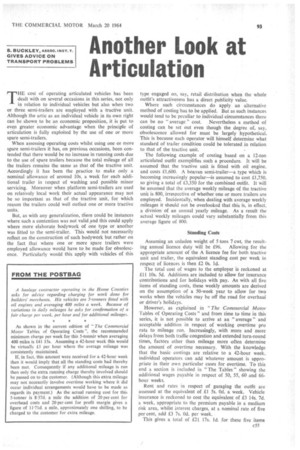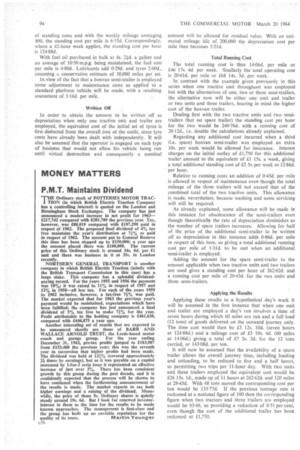Another Look at Articulation
Page 95

Page 96

If you've noticed an error in this article please click here to report it so we can fix it.
THE cost of operating articulated vehicles has been dealt with on several occasions in this series, not only in relation to individual vehicles but also when two or three semi-trailers are employed with a tractive unit. Although the artic as an individual vehicle in its own right can be shown. to be an economic proposition, it is put to even greater economic advantage when the principle of articulation is fully exploited by the use of one or more spare semi-trailers.
When assessing operating costs whilst using one or more spare semi-trailers it has, on previous occasions, been contended that there would be no increase in running costs due to the use of spare trailers because the total mileage of all the trailers remains the same as that of the tractive unit. Accordingly it has been the practice to make only a nominal .allowance of around 10s. a week for each additional trailer in respect of washing and possible minor servicing. Moreover when platform semi-trailers are used on relatively local work their actual appearance may not be so important as that of the tractive unit, for which reason the trailers could well outlast one or more tractive units.
But, as with any generalization, there could be instances where such a contention was not valid and this could apply where more elaborate bodywork of one type or another was fitted to the semi-trailer. This would not necessarily reflect on the construction of such bodywork but rather on the fact that where one or more spare trailers were employed allowance would have to be made for obsolescence. Particularly would this apply with vehicles of this
type engaged on, say, retail distribution when the whole outfit's attractiveness has a direct publicity value.
Where such circumstances do apply an alternative method of costing has to be applied. But as such instances would tend to be peculiar to individual circumstances there can be no " average " cost. Nevertheless a method of costing can be set out even though the degree of, say, obsolescence allowed for must be largely hypothetical. This is because each operator will himself determine what standard of trailer condition could be tolerated in relation to that of the tractive unit.
The following example of costing based on a 12-ton articulated outfit exemplifies such a procedure. It will be assumed that the tractive unit is fitted with oil engine, and costs £1,600. A boxvan semi-trailer—a type which is becoming increasingly popular—is assumed to cost £1,750, so giving a total of £3,350 for the combined outfit. It will be assumed that the average weekly mileage of the tractive unit is 800, irrespective of whether one or more trailers are employed. Incidentally, when dealing with average weekly mileages it should not be overlooked that this is, in effect, a division of art annual yearly mileage. Asa result the actual weekly mileages could vary substantially from this average figure of 800, Standing Costs
Assuming an unladen weight of 5 tons 7 cwt. the result ing annual licence duty will be £96. Allowing for the appropriate amount of the A licence fee for both tractive unit and trailer, the equivalent standing cost per week in respect of licences is then £2 Os. id.
The total cost of wages to the employer is reckoned at 1 10s. 5d. Additions are included to allow for insurance contributions and for holidays with pay. As with all five items of standing costs, these weekly amounts are derived on the assumption of a 50-week year to allow for two weeks when the vehicles may be off the road for overhaul or driver's holidays.
However, as explained in "The Commercial Motor Tables of Operating Costs" and from time to time in this series, it is not possible to arrive at an " average " and acceptable addition in respect of working overtime pro rata to mileage run. Increasingly, with more and more delays from both traffic congestion and extended turn-round times, factors other than mileage more often determine the amount of overtime necessary. With the knowledge that the basic castings are relative to a 42-hour week, individual operators can add whatever amount is appropriate in their own particular cases for overtime. To this end a section is included in "The Tables" showing the additional wages payable in respect of 50, 55, 60 and 66hour weeks.
Rent and rates in respect of garaging the outfit are assessed at the equivalent of £1 5s. Od. a week. Vehicle insurance is reckoned to cost the equivalent of £3 14s. 7d. a week, appropriate to the premium payable in a medium risk area, whilst interest charges, at a nominal rate of five per cent, add £3 7s. Od. per week.
This gives a total of £21 17s. ld. for these five items
of standing costs and with the weekly mileage averaging 800, the standing cost per mile is 6-55d. Correspondingly, where a 42-hour week applies, the standing cost per hour is 124.88d.
With fuel oil purchased in bulk at 4s. a gallon and an average of 10.50 m.p.g. being maintained, the fuel cost per mile is 4.80d. Lubricants add 0.29d. and tyres 2-60d., assuming a conservative estimate of 30,000 miles per set.
In view of the fact that a boxvan semi-trailer is employed some adjustment to maintenance costs as applied to a standard platform vehicle will be made, with a resulting assessment of 3-I6d. per mile.
Written Off
In order to obtain the amount to be written off as depreciation when only one tractive unit and trailer are employed, the equivalent cost of the initial set of tyres is first deducted from the overall e.ost of the outfit, since tyre costs have already been dealt with independently. it will also be assumed that the operator is engaged on such type of business that would not allow his vehicle being run until virtual destruction and consequently a nominal
















































































































































